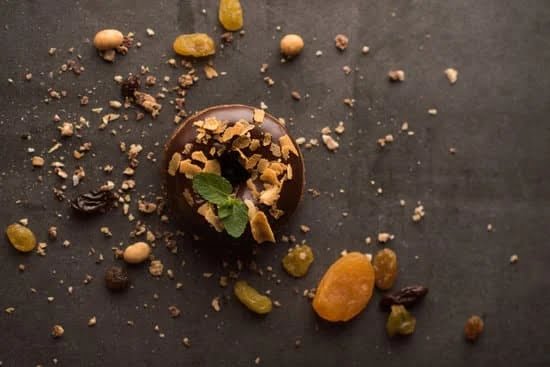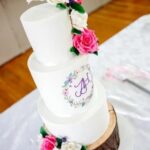Are you looking to learn how to cover a decorated cake? Cake decorating is truly an art, and the covering of a cake is one of the most important aspects of the process. Whether you are a beginner or an experienced baker, mastering the art of cake covering can elevate your baking to a whole new level.
The key to successfully covering a decorated cake lies in having the right tools and ingredients at your disposal. But that’s not all – it also involves proper preparation, choosing the right covering, and adding decorative elements that make your cake truly stand out.
In this article, we will guide you through the essential tools and ingredients needed for covering a cake, as well as how to prepare your cake for decoration. We’ll explore different types of coverings such as fondant, buttercream, or ganache, and provide step-by-step instructions on how to achieve a flawless finish with each.
Additionally, we’ll offer tips for adding decorative elements and troubleshoot common mistakes that may occur during the process. So let’s dive into the wonderful world of cake decorating.
Essential Tools and Ingredients for Covering a Cake
Covering a cake with a beautiful and flawless finish requires the use of essential tools and ingredients. To achieve professional-looking results, it is important to have the right equipment and quality supplies on hand. Some of the essential tools needed for covering a cake include a turntable, offset spatula, bench scraper, rolling pin, and pastry brush. These tools will help you to smoothly apply and shape the covering onto the cake.
In addition to the tools, having the right ingredients is crucial for successful cake covering. For fondant-covered cakes, you will need a good quality fondant in the color of your choice. If you prefer buttercream or ganache as your cake covering, make sure to have high-quality butter or shortening, powdered sugar, and flavorings on hand.
For ganache, you will also need quality chocolate and heavy cream. Using fresh and premium ingredients will contribute to the overall taste and appearance of your decorated cake.
When considering which tools and ingredients to use for covering a cake, it’s important to invest in items that are durable and of high quality. While there are budget-friendly options available, investing in sturdy tools and quality ingredients will ultimately make the process of covering a cake much smoother and more enjoyable.
Preparing the Cake for Decoration
When it comes to decorating a cake, proper preparation is key to achieving a professional-looking finish. Before you can cover your cake with fondant, buttercream, or ganache, it’s important to ensure that the cake has been properly leveled and crumb coated.
Leveling the Cake
Leveling a cake involves trimming off any domed top to create a flat surface. This step is crucial for creating a stable and even foundation for your decoration. To level a cake, use a long serrated knife or cake leveler to carefully slice off the domed portion of the cake. Be sure to work slowly and carefully to achieve a level surface without taking off too much of the cake.
Crumb Coating
Once your cake is leveled, it’s time to apply a crumb coat. A crumb coat is a thin layer of frosting or ganache that locks in any loose crumbs and provides a smooth base for your final layer of decoration.
To crumb coat your cake, spread a thin layer of frosting over the entire surface of the cake using an offset spatula. Make sure to cover the entire cake evenly, then chill it in the fridge for about 15-30 minutes to allow the crumb coat to set.
By properly leveling and crumb coating your cake, you are setting yourself up for success when it comes to covering it with fondant, buttercream, or ganache. These essential preparatory steps ensure that your final decoration will have a clean and polished appearance. With the right tools and technique, you can achieve beautifully decorated cakes that are sure to impress any crowd.
Choosing the Right Covering
When it comes to covering a decorated cake, choosing the right type of covering is crucial in achieving the desired look and taste. The three most popular options for covering a cake are fondant, buttercream, and ganache. Each of these coverings has its own unique characteristics and techniques for application.
Types of Coverings
- Fondant: Fondant is a smooth, pliable icing that is rolled out and draped over the cake for a clean, polished look. It provides a blank canvas for intricate designs and decorations.
- Buttercream: Buttercream is a creamy, spreadable frosting that can be used to cover the entire cake, creating a soft and delicious finish. It is also perfect for piping decorative elements
- Ganache: Ganache is a rich, velvety chocolate mixture that can be poured over the cake or spread onto it for a decadent and glossy finish.
Choosing the Right Covering
Before deciding on which type of covering to use, consider the overall look you want to achieve as well as the flavor profile that would best complement your cake. Fondant offers a sleek and polished appearance with endless possibilities for intricate detailing. Buttercream provides a soft and creamy texture with the option to create beautiful piped designs. Ganache adds richness and elegance with its luxurious chocolatey finish.
When it comes to how to cover a decorated cake, understanding the characteristics of each covering will help you make an informed decision based on your specific needs and preferences.
Step-by-Step Guide to Covering a Cake With Fondant
Covering a cake with fondant can seem like a daunting task, but with the right technique and some practice, you can achieve a smooth and flawless finish that will impress your friends and family. Here’s a step-by-step guide to covering a cake with fondant:
1. Prepare the Cake: Start by ensuring that your cake is level and has been crumb-coated with buttercream or ganache. This will create a smooth surface for the fondant to adhere to.
2. Roll Out the Fondant: Dust your work surface with powdered sugar or cornstarch to prevent the fondant from sticking. Roll out the fondant into a circle large enough to cover the entire cake, about 1/8 inch thick.
3. Drape the Fondant: Carefully lift the rolled-out fondant using a rolling pin and drape it over the cake. Gently smooth the fondant over the top of the cake, then work your way down the sides, smoothing out any wrinkles as you go.
4. Trim Excess Fondant: Use a sharp knife or pizza cutter to trim off any excess fondant around the base of the cake, being careful not to tear or stretch the fondant.
5. Smooth and Finish: Once the excess fondant has been trimmed, use a fondant smoother or your hands to gently smooth out any imperfections and creases in the fondant. Pay special attention to creating clean edges at the base of the cake.
6. Decorate as Desired: At this point, your cake is ready to be decorated further with piping, fondant accents, or edible decorations.
By following these steps, you can learn how to cover a decorated cake with fondant like a pro and create a stunning centerpiece for any special occasion.
Tips for Achieving a Smooth and Flawless Fondant Finish
Covering a cake with fondant can be a daunting task for many bakers, but with the right techniques and tips, achieving a smooth and flawless finish is definitely possible. The key to successfully covering a cake with fondant lies in proper preparation and attention to detail. Here, we will discuss some valuable tips that will help you master the art of achieving a professional-looking fondant finish on your decorated cakes.
First and foremost, it is essential to start with a perfectly smooth frosted cake before applying the fondant. Make sure to crumb coat the cake with a thin layer of buttercream to seal in any crumbs and create a smooth surface. This will ensure that your fondant covering has a flawless base to adhere to.
When rolling out your fondant, be sure to use powdered sugar or cornstarch on your work surface to prevent sticking. Roll the fondant into an even thickness, approximately 1/4 inch thick, and about 2 inches larger than the diameter of your cake. This extra allowance will give you room to work with when smoothing the fondant over the cake.
Once the fondant is draped over the cake, gently smooth it down the sides using smooth, downward motions. Avoid pulling or stretching the fondant, as this can cause tearing or wrinkling. Use a fondant smoother or your hands to gently press out any air bubbles and ensure that the fondant adheres snugly against the cake. With these tips in mind, you can achieve a beautifully covered cake with a flawless fondant finish that will impress both visually and taste-wise.
| Tips for Achieving a Smooth and Flawless Fondant Finish | How to Cover a Decorated Cake |
|---|---|
| Start with a perfectly smooth frosted cake | This extra allowance will give you room when smoothing |
| Avoid pulling or stretching the fondant | Gently press out any air bubbles |
Mastering the Art of Buttercream Cake Covering
Buttercream is a versatile and delicious option for covering a cake, offering a smooth and creamy finish that is perfect for piping and decorating. In this section, we will delve into the process of mastering the art of buttercream cake covering, including essential tools and techniques for achieving a flawless result.
Essential Tools and Techniques
Before diving into the buttercream cake covering process, it’s important to have the right tools on hand. A quality offset spatula, bench scraper, and turntable are essential for achieving smooth and even coverage. Additionally, mastering the technique of crumb coating is crucial for ensuring that your final buttercream layer is free from crumbs and bumps.
Step-by-Step Guide to Buttercream Cake Covering
To cover a cake with buttercream, start by applying a thin layer of frosting to the sides and top of the cake to create a crumb coat. Once the crumb coat has set, apply a thicker layer of buttercream to achieve an even finish. Use an offset spatula to spread the buttercream evenly across the surface of the cake while rotating it on a turntable for smooth coverage.
Tips for Achieving a Flawless Finish
Achieving a flawless buttercream finish requires patience and attention to detail. Using a bench scraper, smooth out the sides and top of the cake while rotating it on the turntable. To create clean edges, hold a straight-edged tool against the side of the cake while gently turning it to remove any excess frosting. For intricate designs or textured finishes, experiment with different piping tips and techniques to elevate your buttercream-covered cakes.
Now that you have mastered the art of buttercream cake covering, you can move on to adding decorative elements such as piping details, fondant accents, or edible decorations to showcase your beautifully covered creation. With these essential tools and techniques in hand, you can confidently cover your cakes with buttercream for professional-looking results every time.
Adding Decorative Elements
Once you have successfully covered your cake with fondant, buttercream, or ganache, it’s time to take it to the next level by adding decorative elements. Piping, fondant accents, and edible decorations can turn a beautifully covered cake into a stunning work of art.
Piping is a technique that involves using a piping bag and various tips to create designs and patterns on a cake. You can use buttercream or royal icing for piping. To pipe on a cake covered with fondant, gently press the tip into the fondant and apply pressure to release the frosting while moving the tip in a steady motion. Practice different piping techniques on parchment paper before decorating your cake to ensure precision.
Fondant accents are another way to add intricate details to your decorated cake. You can create shapes, flowers, ribbons, and other decorations using colored fondant. To attach fondant accents to a fondant-covered cake, brush a small amount of water or clear alcohol onto the back of the accent before gently pressing it onto the cake.
Edible decorations such as edible flowers, shimmer dust, sprinkles, and gold leaf can also be used to enhance the overall look of your decorated cake. These elements can add texture, color, and dimension to your design. When using edible decorations on a buttercream-covered cake, make sure that the surface is firm enough to hold the decorations without causing them to sink or slide off.
These decorative elements are crucial in elevating the appearance of your decorated cake from great to outstanding. By mastering these techniques and incorporating them into your cake decorating process, you can create visually stunning and delectable masterpieces that will surely impress anyone who lays eyes on them.
Troubleshooting
Covering a cake with fondant, buttercream, or ganache can be a fun and rewarding experience, but it’s not without its challenges. Despite your best efforts, you may encounter some common cake covering mistakes along the way. Fortunately, most of these issues are easily fixable with a few simple techniques. In this section, we’ll discuss some of the most common cake covering mishaps and how to troubleshoot and fix them.
One of the most frustrating problems that can occur when covering a cake is air bubbles in the fondant. These unsightly pockets of trapped air can ruin the smooth finish of your cake and make it look unprofessional. To fix this issue, simply puncture the bubble with a small pin or needle and gently smooth out the fondant with your fingers. Be sure to do this carefully to avoid tearing the fondant.
Another common problem when covering a cake with fondant is elephant skin, which occurs when the fondant becomes wrinkled and creased. This can happen if the fondant is rolled out too thin or if it dries out too quickly.
To remedy this issue, try lightly steaming the surface of the fondant with a handheld steamer or by holding it over a pot of boiling water for a few seconds. Then use a cake smoother to gently press out any wrinkles and creases.
Lastly, if you’re working with buttercream or ganache to cover your cake, you may experience bulges or ridges on the surface. This can happen if there are air pockets between the layers of cake or if the filling is too soft.
To fix this problem, place the cake in the refrigerator for about 30 minutes to firm up the filling before continuing to frost or cover it. You can also use a bench scraper to smooth out any imperfections in your frosting layer before adding your final covering.
By being prepared for these common cake covering mistakes and knowing how to fix them, you’ll be better equipped to create beautifully covered cakes that are sure to impress.
Conclusion
In conclusion, the art of cake decorating involves not only creativity and skill but also the ability to cover a cake beautifully. Whether using fondant, buttercream, or ganache, it’s important to have the essential tools and ingredients at hand. Preparing the cake for decoration by leveling and crumb coating is crucial for achieving a flawless finish.
The step-by-step guide provided in this article offers valuable insights into how to cover a decorated cake with fondant, as well as expert tips for achieving a smooth and flawless finish. Mastering the art of buttercream cake covering is another essential skill that every baker should possess. Additionally, adding decorative elements such as piping, fondant accents, and edible decorations can enhance the overall look of the cake.
Finally, troubleshooting common cake covering mistakes and knowing how to fix them is an important aspect of becoming a skilled decorator. With practice and patience, anyone can learn how to cover a decorated cake like a pro. So go ahead and showcase your beautifully covered cake with pride.
Frequently Asked Questions
How Do You Cover a Cake Without Ruining the Icing?
Covering a cake without ruining the icing can be done by using a cake dome or an overturned bowl to provide enough space between the icing and the cover. Alternatively, you can tent the cake with plastic wrap, making sure it doesn’t touch the icing.
How Do You Cover a Decorated Cake Overnight?
When covering a decorated cake overnight, it’s essential to ensure that the decoration is adequately protected. Using a cake box or a large airtight container can help keep the cake fresh and prevent any damage to the decorations.
What Can I Use to Cover a Cake?
There are several options to cover a cake, depending on its size and shape. Cake domes, plastic wrap, aluminum foil, cake boxes, and airtight containers are all suitable for covering cakes and keeping them fresh. It’s important to choose a cover that allows enough space so as not to damage any decorations or frosting on top of the cake.

Welcome to our cake decorating blog! My name is Destiny Flores, and I am the proud owner of a cake decorating business named Cake Karma. Our mission is to provide delicious, beautiful cakes for all occasions. We specialize in creating custom cakes that are tailored specifically to each customer’s individual needs and tastes.





